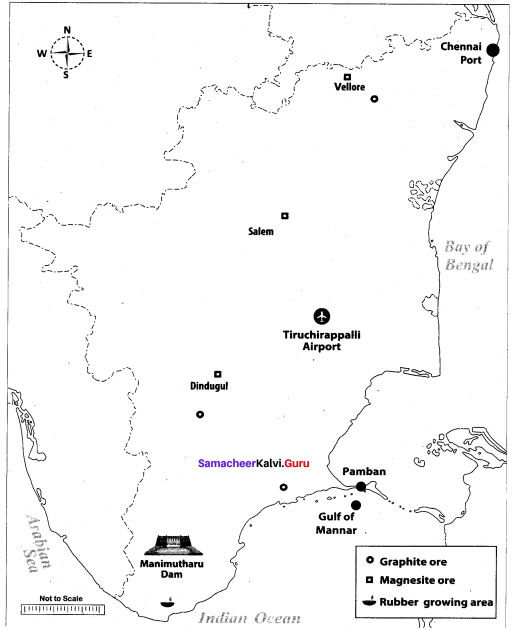Students can Download Samacheer Kalvi 10th Social Science Model Question Paper 1 English Medium Pdf, Samacheer Kalvi 10th Social Science Model Question Papers helps you to revise the complete Tamilnadu State Board New Syllabus and score more marks in your examinations.
This discussion on I want class 10th sst MCQ of all chapter? is done on CBSE Study Group by Class 10 Students.
Tamil Nadu Samacheer Kalvi 10th Social Science Model Question Paper 1 English Medium
General Instructions:
- The question paper comprises of four parts
- You are to attempt all the questions in each part. An internal choice of questions is provided wherever applicable.
- All questions of Part I, II, III and IV are to be attempted separately.
- Question numbers 1 to 14 in Part I are Multiple Choice Questions of one mark each.
These are to be answered by writing the correct answer along with the corresponding option code and the corresponding answer - Question numbers 15 to 28 in Part II are of two marks each. Any one question should be answered compulsorily.
- Question numbers 29 to 42 in Part III are of five marks each. Any one question should be answered compulsorily.
- Question numbers 43 to 44 in Part IV are of Eight marks each. Draw diagrams wherever necessary.
Time: 3 Hours
Maximum Marks: 100
Part – I
Answer all the questions. Choose the correct answer [14 × 1 = 14]
Question 1.
Where did the Ethiopian army defeat the Italian army?
(a) Delville
(b) Orange State
(c) Adowa
(d) Algiers
Answer:
(c) Adowa
Question 2.
With whose conquest did the Mexican civilization collapse?
(a) Hernan Cortes
(b) Francisco Pizarro
(c) Toussaint Louverture
(d) Pedro I
Answer:
(a) Hernan Cortes
![]()
Question 3.
In which year was Sati abolished?
(a) 1827
(b) 1829
(c) 1826
(d) 1927
Answer:
(b) 1829
Question 4.
Who was the first Palayakkarar to resist the East India Company’s policy of territorial aggrandizement?
(a) Marudhu brothers
(b) Puli Thevar
(c) Velunachiyar
(d) Veera Pandya Kattabomman
Answer:
(b) Puli Thevar
Question 5.
established a full-fledged printing press in 1709, at Tranquebar.
(a) Caldwell
(b) F.W.Ellis
(c) Ziegenbalg
(d) Meenakshisundaram
Answer:
(c) Ziegenbalg
Question 6.
The North-South extent of India is
(a) 2,500 km
(b) 2,933 km
(c) 3,214 km
(d) 2,814 km
Answer:
(c) 3,214 km
Question 7.
Pick the odd one out.
(a) Cotton
(b) rice
(c) Wheat
(d) Maize
Answer:
(a) Cotton
Question 8.
The city which is called as the Manchester of South India is
(a) Chennai
(b) Salem
(c) Madurai
(d) Coimbatore
Answer:
(d) Coimbatore
![]()
Question 9.
The highest peak in Tamil Nadu is
(a) Anaimudi
(b) Doddabetta
(c) Mahendragiri
(d) Servarayar
Answer:
(b) Doddabetta
Question 10.
The delta which is known as Granary of South India is
(a) Cauvery delta
(b) Mahanadi delta
(c) Godavari delta
(d) Krishna delta
Answer:
(a) Cauvery delta
Question 11.
How many times has the preamble to the constitution of India amended?
(a) Once
(b) Twice
(c) Thrice
(d) Never
Answer:
(a) Once
Question 12.
Which is not related to our foreign policy?
(a) World co-operation
(b) World peace
(c) Racial equality
(d) Colonialism
Answer:
(d) Colonialism
Question 13.
Which one is a trade policy?
(a) irrigation policy
(b) import and export policy
(c) land-reform policy
(d) Wage policy
Answer:
(b) import and export policy
Question 14.
Tiruppur is known for ………………
(a) Leather tanning
(b) lock making
(c) knit wear
(d) Agro – Processing
Answer:
(c) knit wear
![]()
Part – II
Answer any 10 questions. Question No. 28 is compulsory. [10 × 2 = 20]
Question 15.
How did Great Depression impact on the Indian agriculture?
Answer:
- The Great Depression had a deep impact on the Indian agriculture. The value of farm produce, declined by half, while the land rent to be paid by the peasant, remained unchanged.
- In terms of prices of agricultural commodities, the obligation of the farmers to the state doubled.
Question 16.
How was the Cuban Missile crisis defused?
Answer:
- The Cuban Missile crisis was a confrontation between the United States and the Soviet Union which initiated by the American discovery of Soviet Ballistic missile deployment in Cuba.
- Finally, the Soviet President Nikita Khrushchev agreed to withdraw the missiles and thus the missile crisis was defused.
Question 17.
Explain the concept of constructive swadeshi?
Answer:
Under Constructive Swadeshi the self-defeating modest approach of moderates was rejected and self-help was focused on through swadeshi industries, national schools, arbitration courts and constructive programmes in the village. It was totally non-political in nature.
Question 18.
What do you know of the Cheranmahadevi Gurukulam incident?
Answer:
A Gurukulam was established in Cheranmahadevi by V. V. S. Iyer with the financial support of the Tamil Nadu Congress Committee. However, students were discriminated on the basis of caste. Brahmin and non-Brahmin students were made to dine separately.
Periyar was disturbed to see the discrimination. He questioned the practice, and severely criticised it. Despite his objections the Congress continued to support the iniquitous practice in the Gurukulam. This disappointed Periyar.
Question 19.
Write a brief note on the island group of Lakshaweep.
Answer:
- It lies close to the Malabar coast of Kerala.
- This group of islands is composed of small coral islands.
- Earlier they were known as Laccadive, Minicoy and Amindive. In 1973, these were named as Lakshadweep.
- It covers small area of 32 sq.km. Kavaratti island is the administrative headquarters of Lakshadweep.
- This island group has great diversity of flora and fauna. The Pitti island which is uninhabited, has a bird sanctuary.
Question 20.
State the major Inland waterways of India.
Answer:
The major inland water ways of India are:
- National Waterway 1: It extends between Haldia and Allahabad, measures 1620 km and includes the stretches of the Ganga – Bhagirathi – Hooghly river system.
- National Waterway 2: This waterway includes the stretch of the Brahmaputra river between Dhubri and Sadiya a distance of 891 km.
- National Waterway 3: This waterway extends between Kollam and Kottappuram in the state of Kerala. It is the first national waterway in the country with 24 hour navigation facilities along its entire stretch of 205 km.
Question 21.
Name the major Islands of Tamil Nadu.
Answer:
Pamban, Hare, Krusadai, Nallathanni Theevu, Pullivasal, Srirangam, Upputanni, Island Grounds, Kattupalli Island, Quibble Island and Vivekananda Rock Memorial are some major islands of Tamil Nadu.
Question 22.
List out the air ports and sea ports of Tamil Nadu.
Answer:
Airports:
- Chennai International Airport
- Coimbatore International Airport
- Madurai International Airport
- Tiruchirapalli International Airport
Domestic Airports:
- Tuticorin and Salem
Sea Port: Major Sea Ports are:
- Chennai
- Ennore
- Tuticorin
Intermediate port at Nagapattinam and 15 minor ports.
Question 23.
What are the classical languages in India?
Answer:
There are six classical languages namely – Tamil, Sanskrit, Telugu, Kannada, Malayalam and Odia.
![]()
Question 24.
List any four guiding principles of Panchsheel.
Answer:
Guiding principles of Panchsheel are:
- Mutual Respect for each other’s territorial integrity and sovereignty
- Mutual non-interference
- Equality and co-operation for mutual benefit
- Peaceful co-existence.
Question 25.
Define National Income.
Answer:
National Income is a measure of the total value of goods and services produced by an economy over a period of time, normally a year. National Income is also known as Gross National Product or GNP or National Dividend.
Question 26.
What is globalization?
Answer:
Globalization is the process of integrating various economies of the world without creating any barriers in the free flow of goods and services, technology, capital and even labour or human capital.
Question 27.
Define tax.
Answer:
Tax is levied by government for the development of the state’s economy. The revenue of the government depends upon direct and indirect taxes.
Question 28.
Define the resource and state its types.
Answer:
Any matter or energy derived from the environment that is used by living things including humans is called a natural resource.
Types of Natural Resources are:
- Renewable and
- Non – renewable resources.
Part – III
Answer any 10 questions. Question No. 42 is compulsory. [10 × 5 = 50]
Question 29.
Fill in the blanks
(i) …………..was humiliated by the Treaty of Versailles.
(ii) …………………..makes our toothpaste white.
(iii) The Dutch captured pondicherry in ………………..
(iv) ………………are very important in the modem economic activities of man.
(v) Sathanur dam is constructed across the river………….
Answers
(i) Germany
(ii) Titanium Oxide
(iii) 1693
(iv) Industries
(v)Thenpennai
Question 30.
Match the following
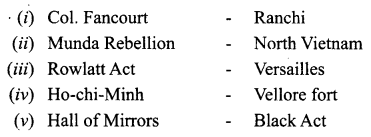
Answer:
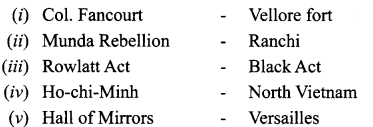
Question 31.
Match the following

Answer:

Question 32.
(a) Distinguish between
(i) GMT and 1ST.
(ii) Weather and Climate,
Answer:
(a) (i) GMT and IST:
GMT :
- It means Greenwich Mean Time.
- GMT is calculated at 0° longitude.
- It passes through Greenwich.
- It is the World Standard Time.
IST:
- It means Indian Standard Time.
- India’s central meridian is 82° 30’ E longitude.
- It passes through Mirzapur.
- It is the Indian Standard Time.
(ii) Weather and Climate:
Answer:
Weather:
- Weather is a day to day conditions of the atmosphere of any place in regard to temperature, pressure, wind, humidity and rainfall.
- It is calculated for a day or a short period of time.
Climate:
- Climate is the average state of weather for a longer period of time at any place.
- To get reliable average of climate, a minimum of 35 years records of weather are necessary.
(b) Give reason: The river Godavari is often referred as Vridha Ganga.
Answer:
- The Godavari is India’s second longest river after Ganga.
- It rises from the slopes of the Western Ghats in the Nasik district of Maharashtra.
- It covers a large number of states as the Ganga does. Because of its large size and extend among the peninsular rivers, the river Godavari is often referred to as Vridha Ganga.
![]()
Question 33.
Narrate the history of transformation of Council of Europe into an European Union.
Answer:
(i) After World War II, it was decided to integrate the states of western Europe. One of the chief objectives was to prevent further European wars by ending the rivalry between France and Germany. In May 1949, ten countries met in London and signed a form called Council of Europe.
(ii) Since the Council of Europe had no real power, a proposal to set up two European organisations were made. Accordingly, the European Defence Community (EDC) and the European Coal and Steel Community (ECSC) were established. Six countries belonging to ECSC signed the treaty of Rome which established the European Economic Community (EEC) or the European Common Market, with headquarters at Brussels.
(iii) The EEC facilitated the elimination of barriers to the movement of goods and services, capital, and labour. It also prohibited public policies or private agreements that restricted market comptetion. Throughout the 1970s and 80s the EEC kept expanding its membership.
(iv) The single European Act came into force on July 1, 1987. It significantly expanded the EEC’s scope giving the meetings of the EPC a legal basis. It also called for more intensive coordination of foreign policy among member countries. According to the SEA each member was given multiple votes, depending on the countries population.
(v) The Maastricht (Netherlands) Treaty signed on February 7, 1992, created the European Union (EU). Today the European Union has 28 member states, and is functioning from its headquarters at Brussels, Belgium.
Question 34.
Eumerate the cause for the failure of the great Revolt of 1857.
Answer:
Administrative changes:
- Disunity among the Indians was the first and the foremost cause.
- A large number of rulers of the Indian states and the big zamindars did not j oin the movement.
- The rulers of the Indian states, who did not support the movement, remained neutral.
- The educated Indians did not support the movement.
- The telegraph and postal communication proved very helpful to the British for proper military actions and sending their reinforcements at the earliest time.
- The rebellious soldiers were short of modem weapons and other materials of war.
- The rebellious soldiers had to fight with traditional weapons which were no match to modem weapons possessed by the British forces.
- The revolt was not extended beyond North.
- The Indian leaders like Nana Saheb, Tantia Tope, Rani Lakshmi Bai where no match to the British generals.
- The revolt broke out prematurely and the preparations for the revolt remained incomplete.
- The organization and the planning of the rebels was very poor.
- The Indian leaders were brave and selfless but they lacked unity of command and discipline.
- The revolutionaries had no common idea.
- The Muslims wanted to revive Mughal rule and the Hindus wanted to receive the Peshwa Raj.
- The British diplomacy of Divide and Rule prevented most of the Indian rulers to j oin together for a common cause.
Question 35.
Write about any two multipurpose projects of India.
Answer:
A comprehensive river valley project which serves a number of purposes simultaneously is called a “Multi purposes project”.
1. The Bhakra Nangal Project: India’s biggest multipurpose river valley project is ‘Bhakra Nangal Project’. It has been built at a strategic point where two hills on either side of the Sutlej are very close to each other. It is the highest gravity dam in the world. Its length is 226 metres from the riverbed. The canals taken out are 1100 kilometres long. The ‘Nangal Power Plant’ on the Sutlej produces electricity, and serves the states of Himachal Pradesh, Punjab, Haryana, Rajasthan and New Delhi. The distributaries are 8400 km in length. It irrigates an area of 1.4 million hectares.
2. Indira Gandhi Project: This project is an ambitious scheme to bring new areas under irrigation so that more areas could be cultivated. The waters of the River Beas and the Ravi are diverted to the River Sutlej. The ‘Pong’ Dam on the River Beas has been constructed to divert the Beas water into the Sutlej in a regulated manner. So that ‘Rajasthan canal’, the longest irrigation canal in the world can irrigate Gandhi Nagar, Bikaner and Jaisalmer districts of North West Rajasthan, (i.e) a part of Thar desert. The main canal now called ‘Indira Gandhi Canal’ is 468 km long runs entirely in Rajasthan, Western of Sutlej, Beas and Ravi are now being fully utilised for irrigating thirsty lands of South Western parts of our country.
![]()
Question 36.
Write about the plantation farming of Tamil Nadu.
Answer:
- Tea, coffee, cashew, rubber and cinchona are the major plantation crops of the state.
- Tamil Nadu ranks second in area and production of tea in India next to Assam.
- Tea plantations are found in the hills of the Nilgiris and Coimbatore.
- Coffee plants are grown in the hills of Western Ghats as well as Eastern Ghats.
- The Nilgiris and Yercaud in Salem are the notable regions for tea plantations.
- It is also found in the hilly slopes of Dindigul, Madurai, Theni and Dharmapuri districts.
- Tamil Nadu stands second in area and in production of coffee next to Karnataka.
- Rubber plantations are significant in Kanyakumari.
- Pepper is confined to the warm and wet slopes of Eastern and Western Ghats of Tamil Nadu. .
- Cashew is extensively cultivated in Cuddalore district.
- Cinchona is planted at heights varying from 1060 to 1280 metres in Anaimalai hills.
- Cardamom estates are located at few places in the hills of Madurai region at an elevation of 915 to 1525 metres.
Question 37.
Explain the salient features of the constitution of India.
Answer:
Here are the salient features of the Indian Constitution.
- It is the lengthiest of all the written Constitutions of the world.
- It is partly rigid and partly flexible.
- It establishes a federal system of Government.
- It establishes the Parliamentary systems not only at the Centre but also in the States.
- It provides an independent judiciary.
- It makes India as a secular state.
- It introduces Universal Adult Franchise and accords the right to vote to all citizens above 18 years of age without any discrimination.
- It provides single citizenship.
- It makes special provisions for minorities, SCs, STs, etc.
Question 38.
Write a short note on SAARC.
Answer:
SAARC:
SAARC means, The South Asian Association for regional co-operation.
- India took the initiative to form SAARC to maintain peace in the regional level.
- SAARC’s first meeting was held at Dacca in Bangladesh in Dec 7, 1985.
- Ashan of Bangladesh was the first secretary general of SAARC.
- The member countries are Bangladesh, Bhutan, India, Maldives, Nepal, Pakistan, Afghanistan and Sri Lanka.
- On April 3, 2007 the SAARC’s annual summit was held in New Delhi. Afghan president Hamid Karzai attended this meeting. Afghanistan became its 8th member.
- 18th SAARC summit took place on 26* and 27* of November 2014 at Kathmandu the capital of Nepal.
- The SAARC countries identified mutual co-operation in the following areas transportation postal service, tourism, shipping meteorology, health, agriculture rural reconstruction and telecommunication.
Question 39.
What are the methods of calculating Gross Domestic Product?
Answer:
Methods of calculating Gross Domestic Product or GDP:
- Expenditure Approach – In this method, the GDP is measured by adding the expenditure on all the final goods and services produced in the country during a specified period.
- Income Approach – This method looks at GDP from the perspective of the earnings of the men and women who are involved in producing the goods and services.
- Value-added Approach – In the value – added approach the value added by each intermediate good is summed to estimate the value of the fiscal good. The sum of the value added by all the intermediate goods used in productions gives us the total value of the final goods produced in the economy.
Question 40.
Briefly explain the nutritional and health status of Tamil Nadu.
Answer:
Status of Nutrition:
- We noted earlier that food security includes nutrition security too. Though our country has reached self-sufficiency in food production, the nutrition status of the population has not seen corresponding levels of improvement.
- In 2015-16, 27% of the rural women and 16% of the urban women (in the age group of 15-49 years) were counted as undernourished or chronically energy deficient by the National Family Health Survey.
- More than half of the women in the reproductive age group (15-49 years) in both rural and urban India were anaemic in 2015-16. As regards children, about 60% of the rural and 56% of the urban children (in the age group of 6-59 months) are counted to be anaemic, in 2015-16.
- About 41 % of the rural and 31 % of urban children are stunted, that is, they are not of the required height in correspondence to their age. Another indicator of nutrition deficiency . among children is “underweight”, which is weight in relation to age.
- In India, in 2015-16, about 20% of children (in the age group of 6-59 months) in rural and urban India are estimated to be underweight.
Question 41.
Draw a time line for the following:
Write any five important events between 1934-1961
Answer:
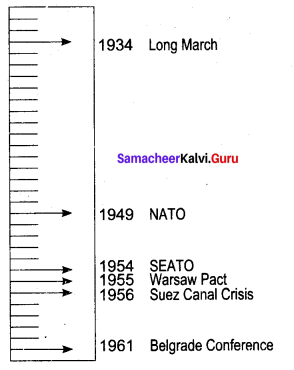
Question 42.
Mark the following places on the world map.
(i) Great Britain
(ii) Germany
(iii) France
(iv) Italy
(v) Greece
Answer:
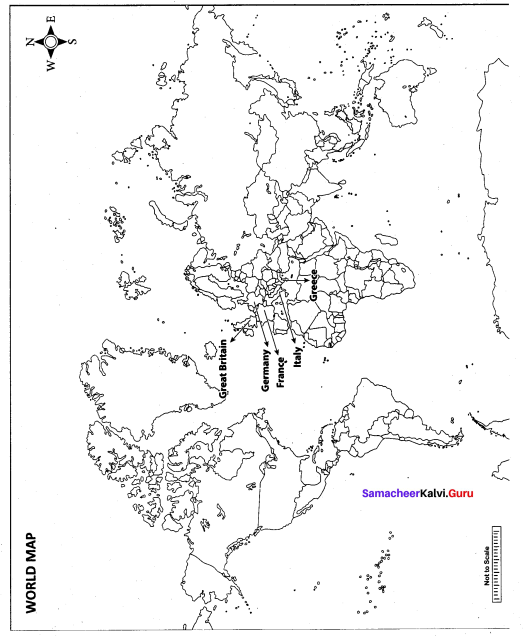
Part – IV
Answer both questions. [2 × 8 = 16]
Question 43.
(a) German Emperor
(i) What was the nature of Emperor Kaiser Wilhelm II of Germany?
(ii) What was the violent form of Germany called?
(iii) Why did Kaiser Wilhelm intervene in the Morocco affair?
(iv) What happened to Germany’s colonies in Africa?
Answer:
(a) German Emperor
(i) The Emperor Kaiser Wilhelm II of Germany was ruthlessly assertive and aggressive. He proclaimed that Germany would be the leader of the world.
(ii) It was called Germany’s Kultur.
(iii) The British agreement with France over the latter’s interest in Morocco was consented by Germany. So Kaiser Wilhelm II of Germany intentionally recognised the independence of the Sultan and demanded an international conference to decide on the future of Morocco.
(iv) The German colonies in western and eastern Africa were attacked by the Allies. As these
colonies were quite far off from Germany they could not receive any immediate help, and therefore had to surrender to the Allies.
(b) Korean War
(i) Who was the President of North Korea during the Korean War?
(ii) Name the southern rival to the President of North Korea.
(iii) How long did the Korean War last?
(iv) What was the human cost of the War?
Answer:
(b) Korean War
(i) Kim II was the President of North Korea during the Korean War.
(ii) Syngman Rhee
(iii) The Korean War lasted three years
(iv) The human cost was enormous, there were 500,000 western casualties and three times that number on the other side. Approximately two million Korean civilian died.
[OR]
Question 43.
(c) The Revolt of 1857
(i) Who assaulted his officer, an incident that led to the outbreak of 1857 Revolt?
(ii) Who was proclaimed the Shahenshah-e-Hindustan in Delhi?
(iii) Who was the correspondent of London Times to report on the brutality of the 1857 revolt?
(iv) What did the Queen’s proclamation say on matters relating to religion?
Answer:
(c) The Revolt of 1857
(i) Mangal Pandey assaulted his officer.
(ii) The Mughal Emperor Bahadur Shah II was proclaimed the Shahenshah-e-Hindustan in Delhi.
(iii) The correspondent’s name was William Howard Russell.
(iv) The Queen proclaimed to the Indian people that the British government would not interfere in traditional institutions and religious matters. ‘
(d) Constructive Programme of Gandhi
(i) What is constructive programme?
(ii) What did Gandhi exhort the Congressmen to do?
(iii) How did Gandhi try to bring about Hindu-Muslim unity?
(iv) What is the contribution of Gandhi towards abolition of untouchability?
Answer:
(d) Constructive Programme of Gandhi
(i) Programmes that aimed at Khadi promotion, Hindu-Muslim unity and the abolition of untouchability are called constructive programmes.
(ii) He exhorted the Congressmen to go throughout their districts and spread the message of Khaddar, the message of Hindu-Muslim unity, the message of anti-untouchability and take up in hand the youth of the country and make them the real soldiers of Swaraj.
(iii) Gandhi tried to bring about Hindu-Muslim unity to strengthen the cause of Swaraj.
(iv) Gandhiji wanted to abolish untouchability from the country. He undertook an all-India tour called the Harijan Tour. He started the Harijan Sevak Sangh to work for the removal of discriminations. He worked to promote education, cleanliness and hygiene and giving up of liquor among the depressed class. He also launched the Temple Entry Movement.
![]()
Question 44.
Mark the following places on the given outline map of India.
(i) Western Ghats
(ii) Mumbai
(iii) Rice cultivation area
(iv) Panna biosphere reserve
(v) Air route from Chennai to Delhi
(vi) Mountain forests
(vii) Direction of South West monsoon
(viii) Cotton growing area
Answer:
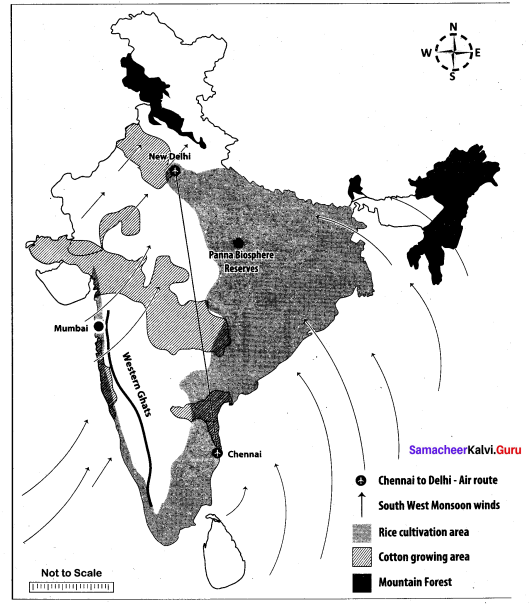
[OR]
Mark the following places on the given outline map of Tamil Nadu:
Answer:
(i) Gulf of Mannar .
(ii) Manimutharu dam
(iii) Pamban
(iv) Chennai port
(v) Any one international airport
(vi) Graphite ore production centre
(vii) Rubber growing area
(viii) Magnesite ore production centre .
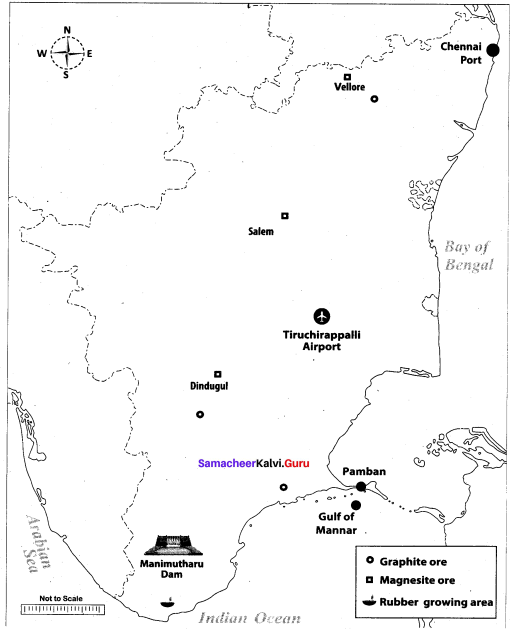
Map for Q 42
(i) Great Britain
(ii) Germany
(iii) France
(iv) Italy
(v) Greece
Answer:
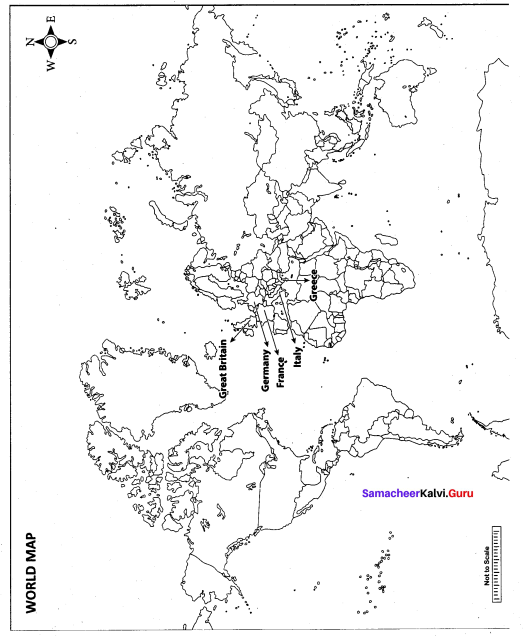
Map for Q. 44
(i) Western Ghats
(ii) Mumbai
(Hi) Rice cultivation area
(iv) Panna biosphere reserve
(v) Air route from Chennai to Delhi
(vi) Mountain forests
(vii) Direction of South West monsoon
(viii) Cotton growing area
Answer:
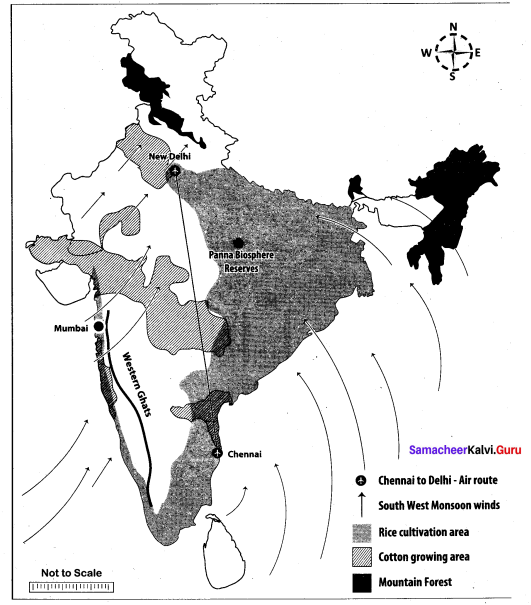
Map for Q. 44
(i) Gulf of Mannar
(ii) Manimutharu dam
(iii) Pamban
(iv) Chennai port
(v) Any one international airport
(vi) Graphite ore production centre
(vii) Rubber growing area
(viii) Magnesite ore production centre
Answer:
